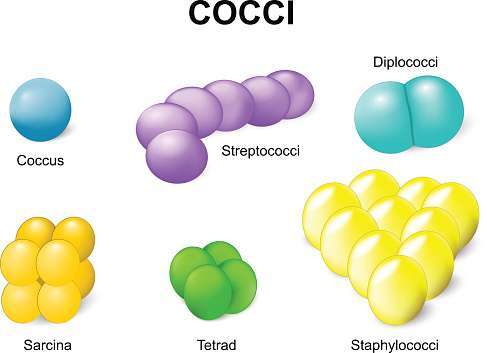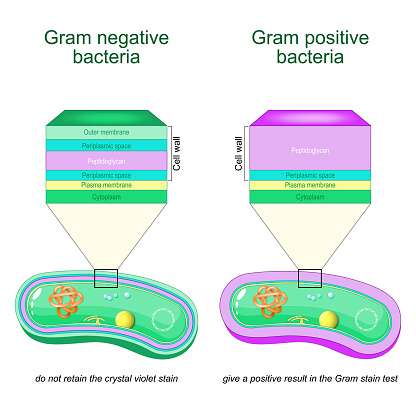Bacteria are single-celled microorganisms that are found in virtually every environment on Earth. They are classified as prokaryotic organisms, which means that they do not have a defined nucleus or other membrane-bound organelles. Bacteria can be further divided into two main groups: gram-positive and gram-negative. They are important in many ecological processes and play a role in the food chain. Some bacteria can cause disease in humans, animals, and plants. Others are used in medicine, food production, and biotechnology.

Classification of Bacteria
Types of Classification of Bacteria
Bacteria can be classified in various ways, but some common methods include:
- Morphological classification: This is based on the shape and structure of the bacteria, such as cocci, bacilli, and spirilla.
- Gram staining: This is a laboratory technique that uses crystal violet and iodine to differentiate between gram-positive and gram-negative bacteria. Gram-positive bacteria have a thick peptidoglycan layer in their cell wall, which retains the crystal violet stain, and appear purple. Gram-negative bacteria have a thinner peptidoglycan layer and an outer membrane, which does not retain the crystal violet stain, and appear pink.
- Metabolic classification: This is based on the bacteria’s metabolic pathways and nutrient requirements, such as aerobes, anaerobes, facultative anaerobes, acid-fast, and phototrophic.
- Phylogenetic classification: This is based on the evolutionary relationships among bacteria, using molecular techniques like 16s rRNA gene sequencing.
- Ecological classification: This is based on the bacteria’s ecological niche and natural habitat, such as soil bacteria, water bacteria, and human-associated bacteria.
Morphological classification of Bacteria
Morphological classification of bacteria is based on the shape and structure of the microorganisms. The three main categories of morphological classification are:
- Cocci: These are spherical or oval-shaped bacteria, often found in clusters. Examples include Streptococcus, Staphylococcus, and Neisseria.
- Bacilli: These are rod-shaped bacteria, often found singly or in pairs. Examples include Escherichia, Pseudomonas, and Bacillus.
- Spirilla: These are spiral-shaped bacteria, often found singly. Examples include Vibrio, Spirillum, and Spirochaete.
It’s worth noting that this classification is not always accurate and some bacteria can change its shape depending on growth conditions and other factors, so other methods such as gram staining and molecular techniques like 16s rRNA gene sequencing are often used in conjunction with morphological classification to identify bacteria.

Gram staining classification of Bacteria
Gram staining is a laboratory technique used to classify bacteria based on the characteristics of their cell wall. The procedure involves adding crystal violet and iodine to a bacterial sample, then washing the sample with alcohol or acetone. The resulting color of the bacteria can be used to differentiate between two main groups:
- Gram-positive bacteria: These bacteria have a thick peptidoglycan layer in their cell wall, which retains the crystal violet stain and appears purple under a microscope. Gram-positive bacteria include species such as Streptococcus, Staphylococcus, and Bacillus.
- Gram-negative bacteria: These bacteria have a thinner peptidoglycan layer and an outer membrane, which does not retain the crystal violet stain and appears pink under a microscope. Gram-negative bacteria include species such as Escherichia, Pseudomonas, and Neisseria.
It’s worth noting that the gram staining is not always accurate and some bacteria can be gram-variable or atypical, meaning that they do not fit perfectly into either gram-positive or gram-negative categories, so other methods such as morphological classification and molecular techniques like 16s rRNA gene sequencing are often used in conjunction with gram staining to identify bacteria.

Metabolic classification of Bacteria
Metabolic classification of bacteria is based on the bacteria’s metabolic pathways and nutrient requirements. The main categories of metabolic classification include:
- Aerobes: These are bacteria that require oxygen for growth and metabolism. They can use oxygen as a final electron acceptor in their respiratory process. Examples include Escherichia coli, Staphylococcus aureus.
- Anaerobes: These are bacteria that do not require oxygen for growth and metabolism and are killed by oxygen. They use alternative electron acceptors in their respiratory process, such as nitrate, sulfur or ferment organic compounds. Examples include Clostridium, Bacteroides.
- Facultative anaerobes: These are bacteria that can grow in the presence or absence of oxygen. They can use oxygen as a final electron acceptor if it is available, but they can also switch to anaerobic metabolism if oxygen is not present. Examples include Streptococcus, Lactobacillus
- Acid-fast: These are bacteria that are resistant to decolorization by weak acid solutions after staining. They have a thick, waxy cell wall that protects them from the acid, and are hard to stain. Mycobacterium tuberculosis, M. leprae are examples of acid-fast bacteria.
- Phototrophic: These are bacteria that can use light as an energy source. They produce pigments called chromophores that absorb light and convert it into chemical energy. Examples include purple and green sulfur bacteria, cyanobacteria
It’s worth noting that this classification is not always accurate, as some bacteria can have multiple metabolic pathways, and can switch between metabolic modes depending on the environment, so other methods such as morphological classification, gram staining, and molecular techniques like 16s rRNA gene sequencing are often used in conjunction with metabolic classification to identify bacteria.
Phylogenetic classification of Bacteria
Phylogenetic classification of bacteria is based on the evolutionary relationships among bacteria. It is done by using molecular techniques such as 16S ribosomal RNA (rRNA) gene sequencing. The 16S rRNA gene is a highly conserved gene found in the ribosome of all bacteria, and its sequence can be used to compare and classify different bacterial species.
This method of classification is based on the concept of “evolutionary distance”, which compares the similarities and differences in the 16S rRNA gene sequences between different bacterial species. The more similar the sequences are, the more closely related the species are considered to be.
Phylogenetic classification can be used to place bacteria into different groups and taxa, such as phyla, classes, orders, families, genera and species. This method of classification is considered to be more accurate and comprehensive than other methods, such as morphological classification, gram staining, and metabolic classification, as it takes into account the evolutionary history and relationships of the bacteria.
It’s worth noting that this classification is not always accurate, as some bacteria can have multiple copies of the 16S rRNA gene in their genome, and therefore it may not reflect the true evolutionary relationships between the bacteria. Also, new species or subspecies can be discovered and new taxa can be created as more data and information become available.
